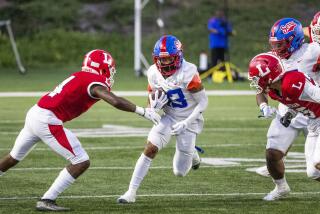Team Sports Striking Out With Amateurs
- Share via
WASHINGTON — For many young people, life is too busy for fun and games.
Casual players have been dropping out of team sports in droves, leaving die-hards in league play to keep amateur sports alive, a survey finds.
“Fewer young people are playing team sports; more specifically, fewer are playing spontaneously, in pickup games, just for the fun of it,” said the report by the Sporting Goods Manufacturers Assn.
With the exception of basketball and soccer, overall participation declined in each of the most popular American team sports between 1990 and 1999, the study said. Even basketball and soccer have shown weakness, starting in 1997, the report said.
The study defined overall participation as playing a sport at least once in a given year. In contrast to occasional participants, the number of frequent participants rose, the study found.
But because there are vastly more people who do something occasionally than people who do something a lot, the net result was a decline in the number of people playing games, the researchers found.
The data were drawn largely from the long-running polling of American Sports Data Inc. in Hartsdale, N.Y., as well as from such sources as national school sports organizations.
Because relatively few Americans engage in team sports after they leave school, the American Sports Data results reflect what young people are doing, the report said. American Sports Data’s nationally representative mail-out questionnaires examine scores of activities.
Basketball was the leading sport, with 39.4 million people ages 6 or older participating at least once in 1999. The overall participation was virtually unchanged from 39.9 million participants in 1990. But it was well below the 45.1 million in 1997. In 1999 alone, the sport lost 7% of overall participants.
In contrast, the number of frequent basketball players, participating 52 times a year or more, rose over the decade by 14%, to 8.8 million, the study said.
Soccer showed an 11% increase for the decade, to 17.6 million players overall, the report said, but overall participation has been statistically fairly steady since 1997. Meanwhile, the decade showed a 41% increase in frequent participants, to 3.8 million.
Other sports are tracking downward, however. For instance, overall baseball participation declined 26% over the decade, to 8.9 million, with frequent players essentially unchanged at 3.2 million. Touch or flag football fell from 20.9 million overall in 1990 to 16.7 million in 1999, while frequent participation fell from 5.6 million to 4.3 million.
The survey did not look for causes of the declines, but industry officials felt the reasons were obvious.
“Casual play across the board for all kinds of things seems to be off,” said Harvey Lauer, American Sports Data’s president. “There are the usual suspects. It’s the competing activities, both physical and video games.”
There also is increased pressure to specialize--”a trend toward one-dimensionality. You got to play soccer, you can’t play football, we want to save you for the Olympics,” Lauer said.
Another factor may be the decline in people in the team-sports age ranges, Lauer said. The Census Bureau projects that, between 1998 and 2005, the proportion of the population under 35 will shrink by 1% while the proportion over 35 will grow by 8%, he said.
“It’s not the aging population; it’s just the non-growth of the younger age segments, which is your prime constituency for these kinds of sports,” Lauer said.
Also, busy working parents, not at home during afternoon play hours, don’t tell their kids to go outside and play, said Mike May, a spokesman for the sporting goods group.
With fewer vacant-lot games, the growth in youth activities has been in things the kids can do alone, such as in-line skating--and now scooters, May said.
The sporting goods industry is feeling the decline in overall participation as a shrinkage in potential sales of things like balls and gloves, said Jim Baugh, president of Wilson Sporting Goods.
No new sports craze is on the horizon--and even if one were, it wouldn’t solve the big problem of inactivity, Baugh said. “Usually, new sports take the people who are prone to be active,” he said. “The answer is, we have got to get active again.”
Baugh and others in the industry are pushing a youth activity campaign, and one key facet is to get more physical education classes in schools. “The biggest issue is with the kids of America, who are more and more obese, and obesity is out of control,” Baugh said. “We have a health crisis coming down the road.”
*
Sporting Goods Manufacturers Assn:
https://www.sgma.com
American Sports Data:
https://www.americansportsdata.com
Sporting goods industry-physical educators Web site to promote physical education in schools: https://weneedpe.com


